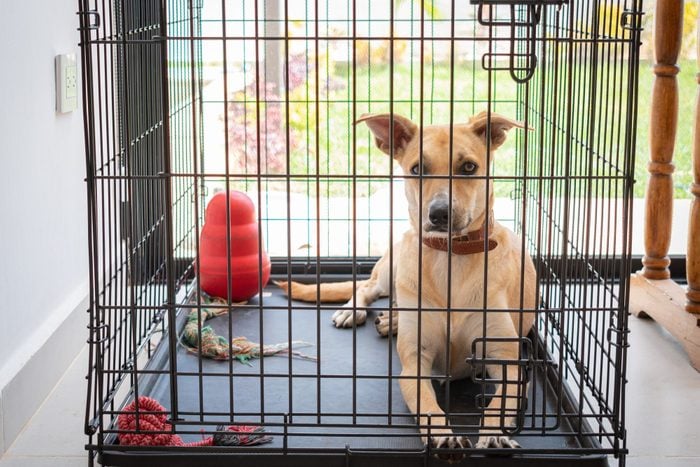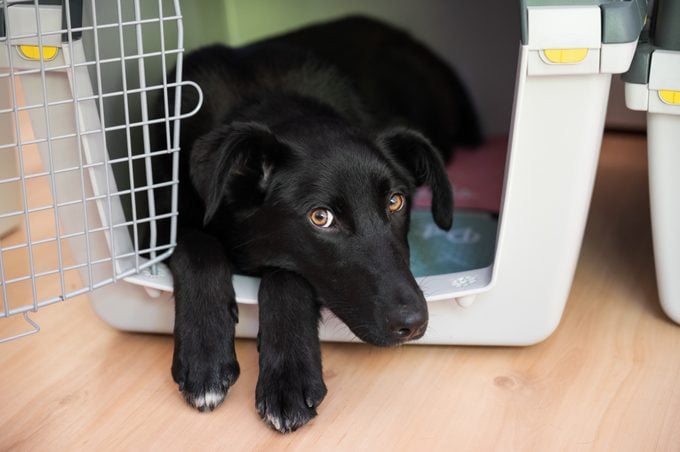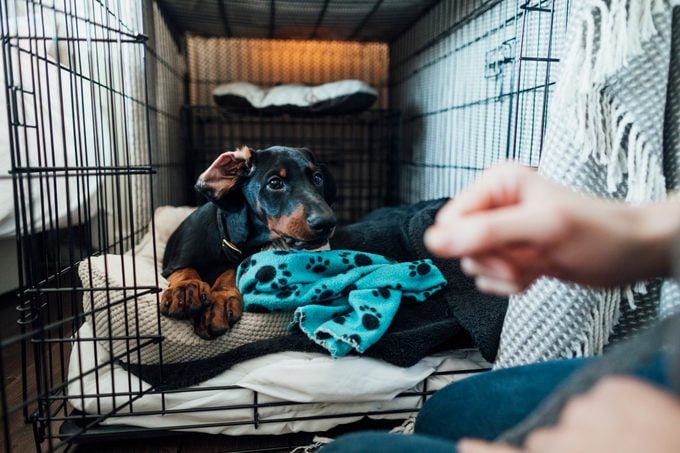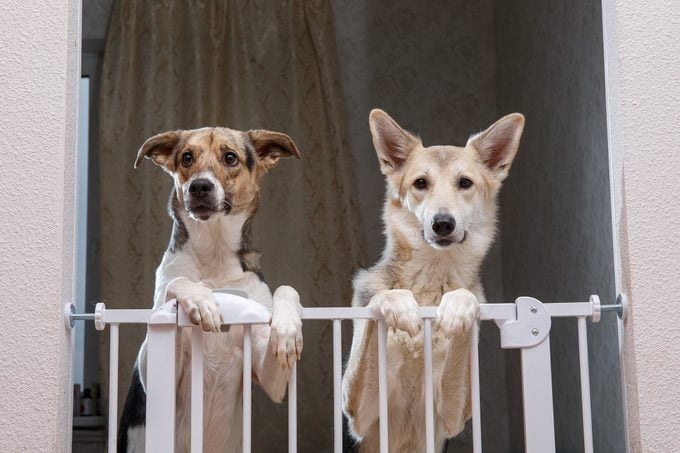How Long Can a Dog Stay in a Crate?
Updated: Aug. 02, 2023

Crate training offers plenty of benefits for you—and your furry friend. Here are the pros' tips for doing it properly, including how long to keep your dog in a crate.
Crate training is one of the most essential parts of training a puppy. For starters, it ensures the safety of your dog (and your new carpet) when you inevitably leave the house to go to work or run errands. But it has benefits for your four-legged friend too, because it’s based on a natural dog behavior. Pups seek out a safe home base when feeling stressed or overwhelmed. While this key skill isn’t terribly difficult to teach your pup, the biggest question for many dog owners is this: How long can a dog stay in a crate?
“In the beginning, you only want to leave them in the crate for a short period of time,” says Cesar Millan, renowned dog behaviorist and co-founder of Halo Collar, the GPS dog safety system. “Dogs can become fearful of a crate if you don’t handle training in the right way.”
If you’ve never learned how to train a dog to use a crate, don’t worry. This guide explains the basics of crate training, including how long dogs can be in a crate, the proper dog commands to use in the process and other helpful tips and tricks. So whether you have one of the hardest dogs to train or one of the easiest dogs to train, you and your pup can both reap the benefits that come with crate training.
Get Reader’s Digest’s Read Up newsletter for more pet tips, humor, cleaning, travel, tech and fun facts all week long.
What is crate training?
Crate training is the process of teaching a dog to stay in a confined space, usually a wire crate, for a period of time. Your four-legged friend has a natural instinct to seek out a safe space when he’s stressed, but it’ll take some time for him to understand the role of his crate. That’s where the training process comes in—you’ll teach your dog the role of the crate and what to expect from it.
Why is crate training important?
There are many reasons experts regard crate training as a key element of a new-puppy checklist. The crate can be a great tool for other types of training and a comforting retreat for your pup. Here are a few ways your dog’s crate is helpful to both man and man’s best friend:
It creates a safe space for dogs
“It is important to create safe places in your home where your pup can feel safe and secure and has the chance to escape the chaos of family life,” says Ragen McGowan, PhD, an animal behavior scientist at Purina. “Crate training can be a good way to provide this security.”
It prevents destructive behaviors
Keeping a dog, especially a puppy, in a crate when you cannot be around to supervise also helps prevent accidents and other destructive behavior that puppies are prone to. In other words, the crate can keep your dog from peeing in the house, making a snack of your favorite shoes or getting into other trouble.
“Crate training your dog can help eliminate bad behaviors because the dog has a place to go when anxious,” says Millan.
It can help with housebreaking
Dogs don’t like to go potty where they sleep, according to the American Kennel Club, so crate training can be a great way to teach them how to hold their bladder. While the technique works on older dogs, crate training is especially useful when you’re learning how to potty train a puppy.
It makes for safer, easier travel
Getting a dog used to being in a crate from a young age can also come in handy when you have to travel with your dog or take it to the vet or groomer, says McGowan. Pet parents on the go will need to tote their pup in a crate or carrier, so do yourself a favor and acclimate your little guy to the space before your big vacation. It’ll mean a safer trip for the humans in the family (especially if your dog has a tendency to distract the driver) and a more pleasant trip for your animal.
It can help a dog’s physical and mental health
Dogs may prefer their cozy crate when they aren’t feeling well, and staying somewhat confined can prevent further injury when a dog is recovering from an injury or illness. Crate training can also help prevent separation anxiety, says McGowan, as dogs feel safe and comforted simply by being inside their crate.
What are the possible drawbacks of crate training?

While most experts agree that crate training has many positives, there are times when things can go wrong. Read on to find out what you need to know before you begin.
Extended use can cause added stress
While short stints in a crate can be relaxing for dogs, spending too long in such confinement can cause them emotional and physical stress. That’s why “How long can a dog stay in a crate?” is a crucial question to ask before you crate your pup. A dog confined for too long can become depressed.
Crates can pose some safety concerns
Depending on the crate’s construction, a dog collar or harness could get stuck on it. Similarly, dogs can choke on toys or treats if they are left inside the crate and no one is supervising.
Dogs develop a negative association with crates used as punishment
Just as proper crate training teaches a dog to appreciate and seek out the comfort of a crate, using the crate for punishment, even occasionally, can cause a dog to associate it with negative things. This can defeat the purpose of crate training your dog.
Improperly sized crates can be too confining
You want to make sure that whatever crate you use for training is the right size for your dog—usually large enough that they can turn around in it—and that you size up as your dog grows. If a crate is too small, your dog may feel claustrophobic rather than comforted.
How long can a dog stay in a crate?
When you first start crate training, begin slowly. Don’t leave your dog alone in a crate for hours at a time.
How long can a dog be in a crate? “For puppies, I would recommend starting by only leaving them crated for two hours or less and working up to five to six hours once they’re potty trained,” says McGowan. “For adult dogs, I would not recommend leaving them crated for longer than six to eight hours, as that can be damaging to their mental and physical health.”
She recommends leaving the crate door open when you are home so that your dog can enter and leave the crate freely. Many dogs prefer to nap in their crate or to retreat there with a favorite toy or treat.
How to make your dog’s crate safe
While this type of training can be a great thing, crates do pose a few hazards, so it’s important to know how to make yours a safe place for your pup. Here are some useful tips:
- Make sure the crate is the correct size. There are many different styles of crates, from dog crate furniture that multitasks and blends in with your decor to inflatable dog crates. Style is less important than size, however. McGowan says the size of the crate depends on the size of the dog. She uses this as a rule of thumb: The crate should be 4 inches longer than your dog measures from the tip of his nose to the end of his tail.
- Don’t use leashes or collars. They can snag on the crate and choke your dog, so it’s best to remove them while your dog is inside the crate.
- Use crate pads or bedding designed for dogs. Dogs (especially puppies) may chew or shred fabric or blankets, which can pose a choking hazard.
- Choose toys wisely. Don’t leave toys or treats in the crate that your dog may choke on unless you are there to supervise. When you leave the house with your dog crated, make sure the area is clear of choking hazards.
- Place the crate in a safe, quiet, temperature-controlled location. You don’t want your pup to get overheated or chilly or to be exposed to loud noises or other unpleasant sensory stimuli that he can’t avoid.
How to crate train a dog

Ready to give crate training a try? The four-step process below will help you and your dog use a crate the right way.
Step 1: Familiarize your dog with the crate
Let your pup sniff and explore the crate on his own. Praise him when he’s inside the crate—he’s being a very good boy.
Never force a dog into a crate, McGowan says. If your dog is reluctant to enter, you can use positive reinforcement and encouragement, such as tossing in a small treat or toy as an incentive. You can also add a dog bed or blankets inside to create a comfy resting spot.
Step 2: Close the crate door
Once your dog is comfortable inside the crate, try closing the crate door for a few minutes at a time. Stand right next to it so your dog can see you and be comforted by your presence with the crate door closed. Praise your pup or give him a treat when he’s inside the crate.
Step 3: Gradually move away from the crate
With the crate door closed, start moving away from the crate: first, take a few steps back. Then move across the room. And finally, move into the next room, out of sight. This will allow your dog to gradually grow comfortable in the crate without you there.
Step 4: Slowly increase the amount of time your dog spends in the crate
As your pet becomes more comfortable being alone for short periods of time, gradually increase the amount of time he spends in his crate. Work in increments, aiming for an hour or more. Eventually, you should be able to leave your dog in the crate overnight.
Just be sure that you’re not leaving your pup for too long during this step. How long can a dog stay in a crate? Remember, puppies should stay crated for no more than six hours, and adult dogs should remain in a crate for no more than eight hours.
Tips for crate training your dog
Depending on the dog and the trainer, crate training may be smooth sailing or have some bumps along the way. These tips can help.
Don’t reward whining
If at any point in the training process, your dog begins to whine, do not open the crate immediately, as that may only increase the behavior by teaching him that whining will get him out of the crate. Instead, wait until he isn’t whining to open the crate.
Try feeding in the crate
“Nothing is more positive for dogs than food,” says McGowan. Feeding a dog in the crate may help create a positive association.
Place the food bowl in the crate and allow your pup to eat with the door open. If your dog is hesitant, start by placing the bowl outside the crate, and gradually move it further into the crate each time you feed him.
Keep calm
You want your dog to be calm when in the crate, so don’t fill it with a lot of toys or treats. And remember to maintain a steady demeanor yourself. Once the animal has settled, leave quickly, without a big fuss, so your dog doesn’t get excited or upset.
Establish a routine
You know what your dogs want from you? A routine. Truly—they thrive on it. So establish a practice in which your pup spends designated time in the crate even when the whole family is home.
Alternatives to crate training

While crate training has many benefits, not everyone—human or canine—is a fan. If your dog does not get comfortable with the crate, you can try other methods such as:
Dog gates
“If you don’t have a crate, using a baby gate to shut off a small area of your home can work to give your dog a safe resting space and prevent them from being as destructive as they might be if they had free rein in your home,” says McGowan.
Playpens
Millan says that playpens, like those made for small children, can have a similar effect as a crate. Some dogs may feel more comfortable in a space without an enclosed ceiling. Just make sure your furry friend can’t get out!
Doggy day care
If your dog resists crate training and you need to be away from home (and can’t bring your dog with you), having someone else watch your four-legged pal is always an option. As an added bonus, your pup can socialize with other canine companions.
About the experts
- Cesar Millan is a renowned dog behaviorist and star of the television show The Dog Whisperer. He is also the co-founder of Halo Collar, a GPS dog safety system.
- Ragen McGowan, PhD, has more than 20 years of experience researching animal behavior. She has worked for Purina as an animal behavior specialist for more than a decade.



